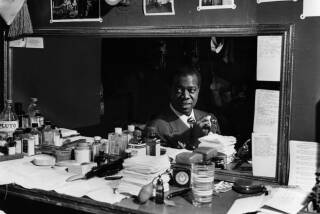Ives: Mt. Rushmore of American Music
- Share via
Twenty years ago, on the eve of the centennial of Charles Ives’ birth, America was no longer mad about its putatively favorite native musical genius. Ives madness had crested nearly a decade earlier, when he was enshrined in the annals of American hyperbole by Leonard Bernstein, who called him “our Washington, Lincoln and Jefferson of Music.”
Ives, an utterly un-ordinary American, nonetheless was a huckster’s dream American: a self-made, New England-born millionaire (in the insurance business) who (we were told) spent his spare time being a musical genius-innovator without recourse to a lot of scholarship or concertgoing.
As it turned out, Ives didn’t write much music that was as accessible as his Brahmsian-Dvorakian Second Symphony, with which Bernstein made Ives’ name.
Then, too, there was bad press associated with that lovely work and some of the composer’s other creations, dark suggestions--attributable chiefly to fellow composer Elliott Carter--that many of Ives’ wildly prophetic harmonic innovations from the turn of the century were in fact later inventions, added after he had become familiar with the works of the progressive composers he purportedly foreshadowed.
Ives didn’t quite fade away after 1974. He did, however, become very quiet--until now. Suddenly, Ives is being performed again, in Europe more than at home, and recorded. What is being recorded is some of the music that most clearly indicates his right to be classed among the American greats, and not merely its cranks.
The most “progressive” of Ives’ works to gain a sizable following during the 1960s heyday, in contrast to the soothing Second Symphony, was the abrasive and farsighted “Three Places in New England,” with its impressionistic evocations of place and mood, and the marching-bands-from-hell dissonances, replete with a welter of simultaneously played American folk tunes.
The work was--and remains--a joy and a musical marvel, whether or not Ives touched it up over the years beginning in 1903.
Of the three recorded editions of “Three Places” recently received, one is a reissue of the famous 1957 edition in which the late Howard Hanson led his Eastman-Rochester Orchestra with a winning combination of raw vigor and sensitivity to detail (Mercury “Living Presence” 432 755, mid-price) that brought the music thrillingly to life.
In its handsome-sounding CD transfer, with Ives’ benign, hymn-inspired Third Symphony (“The Camp Meeting”) and works by William Schuman and Peter Mennin, it reassumes the status of a classic--an irresistibly vital classic at that.
The most convincingly Ivesian “Three Places” since Hanson’s comes from an unlikely source: the Gulbenkian) Orchestra of Portugal under its French conductor, Michel Swierczewski (Nimbus 5316).
These people, hardly less than Hanson and company, are deeply, enthusiastically into the spirit of the music and have received the right kind of sonics, a tricky business with Ives, giving the blaring brass its due and the solo piano, a critical part of the Ives sound, the requisite prominence.
Nimbus’ Ives program further includes the hypnotic, mystical “Unanswered Question,” the raucous, ragtime-inspired “Central Park in the Dark” and the impenetrably dense “Robert Browning” Overture.
The last--and least--of the current crop of “Three Places” is from a normally reliable source, Leonard Slatkin and his Saint Louis Symphony (RCA Victor 61222).
Conspicuously lacking here are the final measure of Ives’ raw, climactic yawp. Slatkin--with his engineers sharing the blame--softens the blows of “Putnam’s Camp” with a sort of recessed sonic ambience, glassy-smooth rather than rock-strewn, although one can find solace in the sheer beauty of orchestral sound produced in the opening “St. Gaudens” movement.
The coupling is again the Third Symphony, which takes well to Slatkin’s (and the engineers’) easygoing approach, and “The Unanswered Question” and “Central Park,” both more elegant, less immediate in both sonics and emotional feel, than the Nimbus versions.
More to Read
The biggest entertainment stories
Get our big stories about Hollywood, film, television, music, arts, culture and more right in your inbox as soon as they publish.
You may occasionally receive promotional content from the Los Angeles Times.










